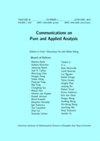Existence of minimizers for non-quasiconvex functionals by strict monotonicity
IF 1
3区 数学
Q1 MATHEMATICS
引用次数: 0
Abstract
We consider functionals of the form $ \begin{equation*} \mathcal{F}(u) = \displaystyle{\int}_{ \Omega} f(x, u(x), D u(x))\, dx, \quad u\in u_0 + W_0^{1, r}( \Omega, {\mathbb{R}^m}), \end{equation*} $ where the integrand $ f = f(x, p, \xi): \Omega\times \mathbb{R}^m\times \mathbb{M}^{m\times n} \to \mathbb{R} $ is assumed to be non-quasiconvex in the last variable and $ u_0 $ is an arbitrary boundary value. We study the minimum problem by the introduction of the lower quasiconvex envelope $ \overline{f} $ of $ f $ and of the relaxed functional$ \begin{equation*} \overline{\mathcal{F}}(u) = \displaystyle{\int}_{ \Omega} \overline{f}(x, u(x), D u(x))\, dx, \quad u\in u_0 + W_0^{1, r}( \Omega, {\mathbb{R}^m}), \end{equation*} $imposing standard differentiability and growth properties on $ \overline{f} $. Then we assume the quasiaffinity of $ \overline{f} $ on the set in which $ f> \overline{f} $ and the strict monotonicity of the map $ \mathbb{R}\ni p^i \mapsto \overline{f}(x, p, \xi) $, where $ p^i $ is a single scalar component of the vector function variable $ p $, showing that any minimizer of $ \overline{\mathcal{F}} $ minimizes $ \mathcal{F} $ too.非拟凸泛函严格单调性下极小值的存在性
我们考虑形式为$ \begin{equation*} \mathcal{F}(u) = \displaystyle{\int}_{ \Omega} f(x, u(x), D u(x))\, dx, \quad u\in u_0 + W_0^{1, r}( \Omega, {\mathbb{R}^m}), \end{equation*} $的泛函,其中被积函数$ f = f(x, p, \xi): \Omega\times \mathbb{R}^m\times \mathbb{M}^{m\times n} \to \mathbb{R} $被假定为最后一个变量的非拟凸,$ u_0 $是任意的边值。我们通过引入$ f $的下拟凸包络$ \overline{f} $和施加于$ \overline{f} $的标准可微性和生长性质的松弛泛函$ \begin{equation*} \overline{\mathcal{F}}(u) = \displaystyle{\int}_{ \Omega} \overline{f}(x, u(x), D u(x))\, dx, \quad u\in u_0 + W_0^{1, r}( \Omega, {\mathbb{R}^m}), \end{equation*} $来研究最小值问题。然后我们假设$ \overline{f} $在$ f> \overline{f} $所在集合上的拟亲和性和映射$ \mathbb{R}\ni p^i \mapsto \overline{f}(x, p, \xi) $的严格单调性,其中$ p^i $是向量函数变量$ p $的单个标量分量,表明$ \overline{\mathcal{F}} $的任何最小化器也最小化$ \mathcal{F} $。
本文章由计算机程序翻译,如有差异,请以英文原文为准。
求助全文
约1分钟内获得全文
求助全文
来源期刊
CiteScore
1.90
自引率
10.00%
发文量
124
审稿时长
4-8 weeks
期刊介绍:
CPAA publishes original research papers of the highest quality in all the major areas of analysis and its applications, with a central theme on theoretical and numeric differential equations. Invited expository articles are also published from time to time. It is edited by a group of energetic leaders to guarantee the journal''s highest standard and closest link to the scientific communities.

 求助内容:
求助内容: 应助结果提醒方式:
应助结果提醒方式:


